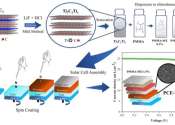Unbroken: New soft electronics don't break, even when punctured
Want a smartphone that stretches, takes damage, and still doesn't miss a call?
Jun 26, 2021
0
145
Electronics & Semiconductors

Want a smartphone that stretches, takes damage, and still doesn't miss a call?
Jun 26, 2021
0
145
Electronics & Semiconductors

Electronic organic materials offer promise to support alternative and green energy sources to meet escalating global energy demands and strict environmental regulations. A KAUST-led team has now developed electron-transporting, ...
Mar 17, 2021
0
112
Electronics & Semiconductors

More precise, faster, cheaper: Researchers all over the world have been working for years on producing electrical circuits using additive processes such as robotic 3D-printing (so-called robocasting) with great success, but ...
Dec 20, 2021
0
177
Electronics & Semiconductors

A soft and flexible electronic "e-skin," so sensitive it can detect the minute temperature difference between an inhaled and an exhaled breath, could form the basis of a new form of on-skin biosensor. The ultrathin material ...
Nov 29, 2022
0
85
Energy & Green Tech

Scientists have discovered a stable and highly conductive lithium-ion conductor for use as solid electrolytes for solid-state lithium-ion batteries.
Apr 2, 2024
0
71
Electronics & Semiconductors

In an article published in the Journal of Materials Chemistry C, Brazilian researchers describe a strategy to enhance the efficiency and stability of solar cells made of perovskite, a semiconductor material produced in the ...
Feb 26, 2024
0
29
Engineering

Several industrial, automotive and health care applications rely on accurate and precise measurement of pressure. Flexible and wearable pressure sensors are typically fabricated using petroleum-based polymers. The solid waste ...
Sep 20, 2022
0
29
Energy & Green Tech

North Carolina State University engineers have demonstrated a flexible device that harvests the heat energy from the human body to monitor health. The device surpasses all other flexible harvesters that use body heat as the ...
Jan 30, 2020
0
84
Electronics & Semiconductors

Researchers at Linköping University, Sweden, have developed a new, more environmentally friendly way to create conductive inks for use in organic electronics such as solar cells, artificial neurons, and soft sensors. The ...
Jan 22, 2024
0
101
Engineering

The research team led by Professor Jong-Sung Yu of the Department of Energy Science and Engineering at DGIST has developed a low-temperature method to synthesize a highly graphitized carbon support that will greatly improve ...
Mar 31, 2023
0
42